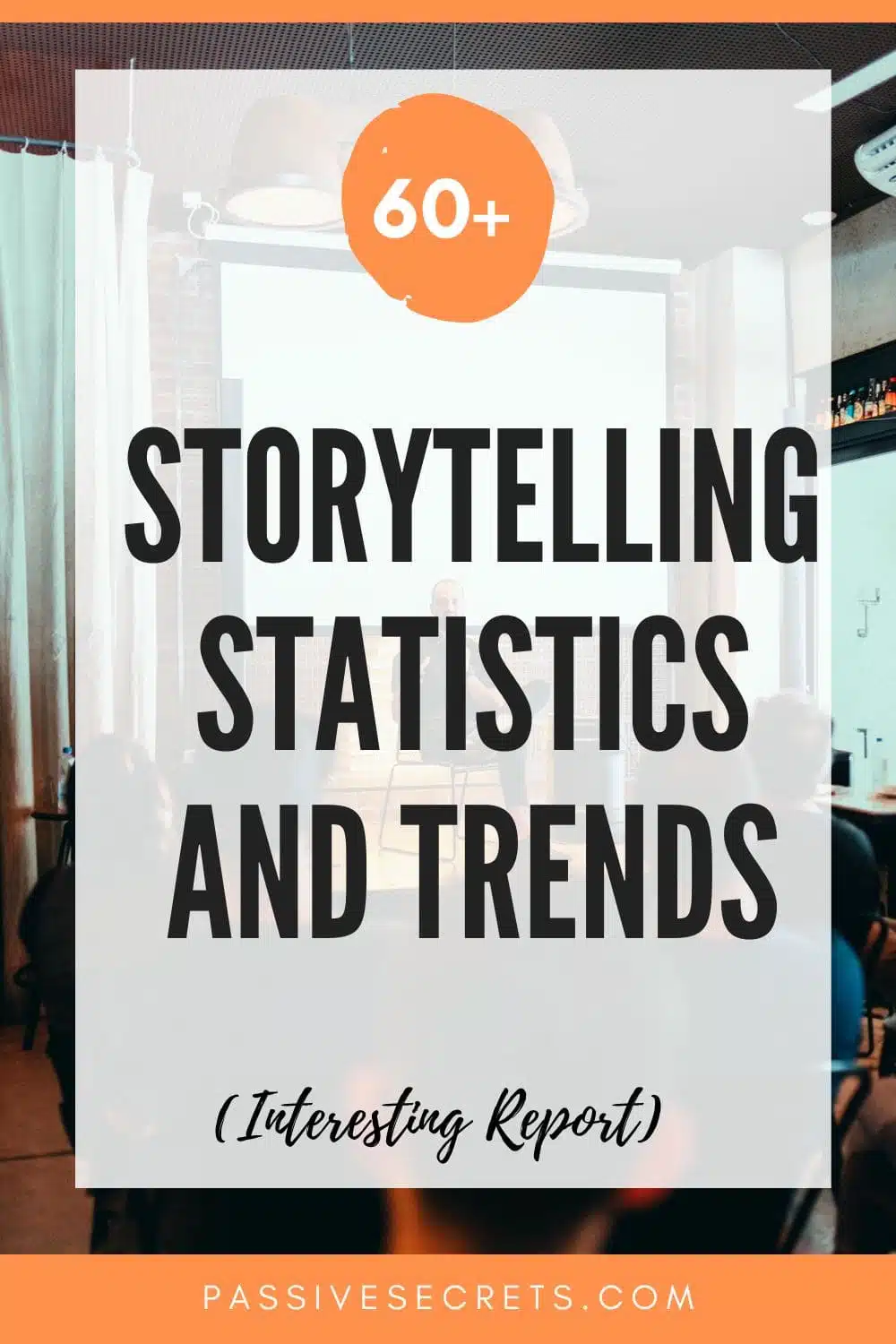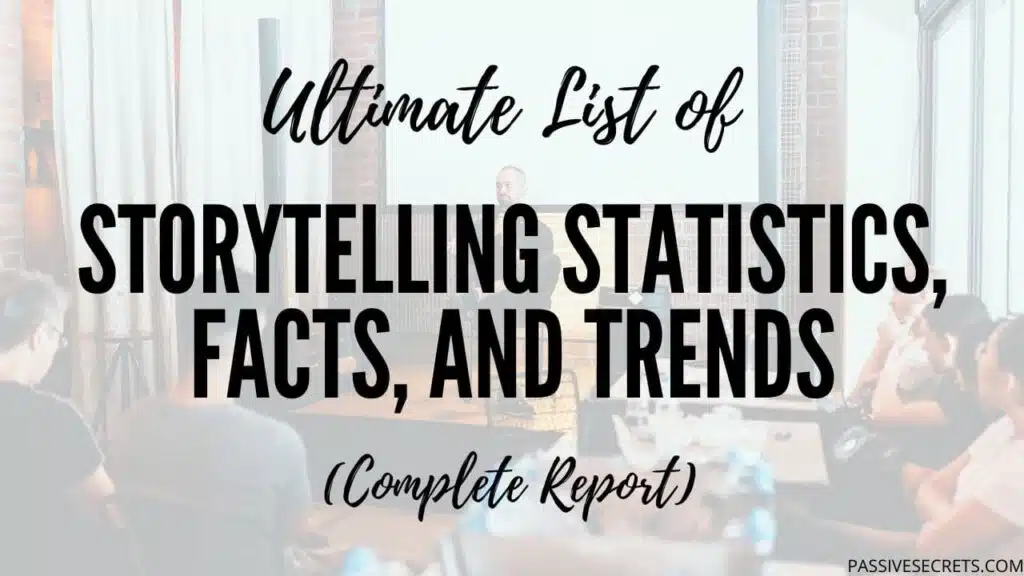
Storytelling is as old as man, and it is the secret ingredient to effective marketing in the business world.
The art of storytelling has evolved from simply conveying information to creating engaging narratives that resonate with audiences on a deeper level.
As the world is now data-driven, so is brand storytelling.
Data storytelling involves using data to craft compelling stories that inform, persuade, and inspire.
From organizations to individuals, data storytelling has become an essential tool for communicating complex information in an informative and engaging way.
But what are the statistics behind this powerful technique?
In this article, we’ll explore some exciting storytelling statistics highlighting its impact on audiences and the benefits it can bring to businesses and organizations.
Key Storytelling Statistics (Editor’s Pick)
- Stories are remembered up to 22 times more than facts alone.
- Storytelling can boost conversion rates by 30%.
- Researchers discovered that people retain only 5% to 10% of material that consists solely of statistics. However, they remember between 65% and 70% when it’s a story.
- 47% of authors in the US used AI as a grammar tool, and 29 % used it to brainstorm plot ideas and characters.
- Consumers prefer to hear brand stories through advertising rather than word of mouth.
- AI-generated content plays a crucial role in data-driven storytelling, providing insights and narratives based on data.
- AI can help with all aspects of video production, from scripting and storyboarding to automating the editing process and improving visual effects.
Storytelling Statistics: Market Size
1. Between 2023 and 2028, the digital storytelling courses market is expected to rise at a CAGR of 9.87%, totaling USD 267.84 million. (source)
2. North America is expected to contribute 39% of the worldwide digital storytelling market’s growth over the forecast period. (source)
3. In 2018, the degree segment of the digital storytelling course market was the largest, valued at USD 291.78 million. (source)
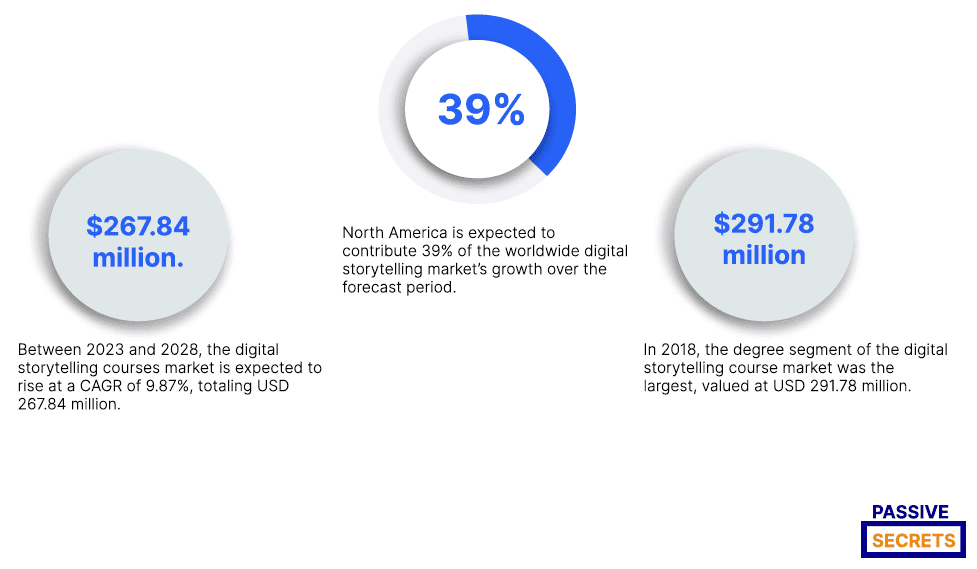
Brand Storytelling Statistics
4. Dove, one of Unilever’s biggest soap brands, uses the storyboarding or digital storytelling strategy to grow their consumer base. The company uses the stories of real people to build an emotional connection with their target audience. (source)
5. In a 2023 study, 78% of responding marketing decision-makers from the United Kingdom said personal/human-first messaging was an essential part of storytelling. 79% chose “creating an emotional response” as the most essential element of storytelling. (source)
6. 73.67% of respondents use stories to convey sales information. (source)
7. Storytelling can boost conversion rates by 30%. (source)
8. Even 62% of B2B marketers believe storytelling is an effective content marketing approach. (source)
9. Stories can be recalled up to 22 times better than facts alone. The human mind is hardwired to remember stories, especially those with which they have an emotional connection. (source)
10. Sponsored content that appears to be legitimate news or relevant storytelling is more effective than traditional advertising in reaching all generations. (source)
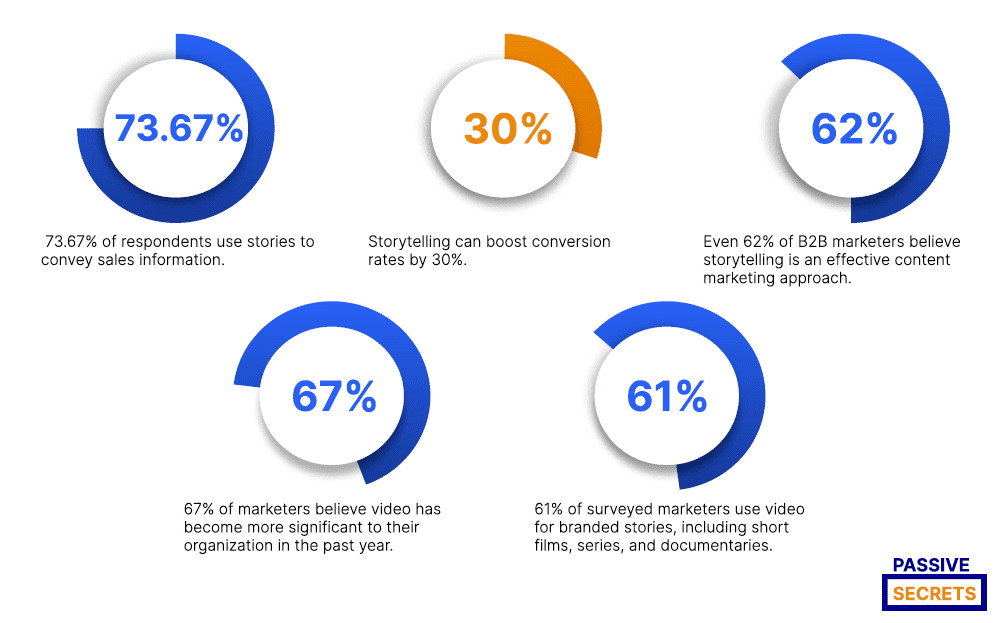
11. 67% of marketers believe video has become more significant to their organization in the past year. However, only 7% believe they use it to its total capacity. (source)
12. 61% of surveyed marketers use video for branded stories, including short films, series, and documentaries. (source)
13. 44% say branded video stories are the video type that produces the best content marketing results. (source)
14. A survey found that 55% of consumers who love a brand’s story are willing to buy. (source)
15. 66% of people believe the best and most engaging brand storytelling is those about regular people. (source)
16. 64% of respondents believe that telling good stories helps brands connect with customers. (source)
17. 57% of respondents enjoy stories about actual people. (source)
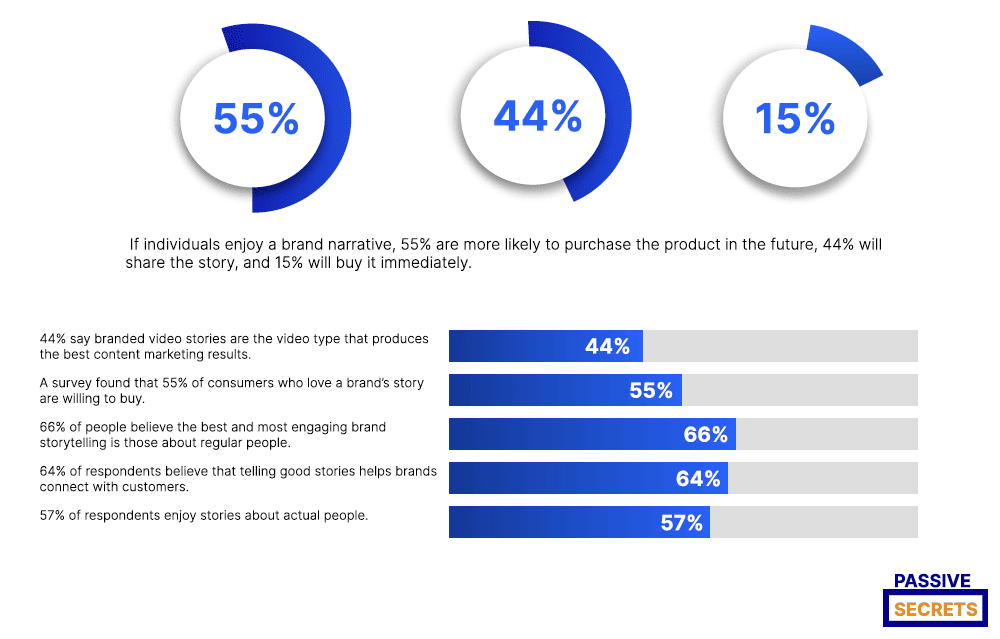
18. Consumers prefer to hear brand stories through advertising rather than word of mouth, with the brand’s website, blog, or newsletter rating the highest. (source)
19. Chris Haddad increased his conversion rate from 2% to 8% after telling a story on his landing page. (source)
20. A product-related story in the news, magazine, or newspaper has 40% more impact on younger people aged 18 to 34 than traditional advertising. (source)
21. Storytelling can be one of the most effective ways for marketers to reach their target audience. (source)
22. If individuals enjoy a brand narrative, 55% are more likely to purchase the product in the future, 44% will share the story, and 15% will buy it immediately. (source)
23. Researchers discovered that people retain only 5% to 10% of information that consists solely of statistics. However, they remember between 65% and 70% when it’s a story. (source)
24. When a story is recounted, the human brain releases cortisol, dopamine, and oxytocin, which help people retain knowledge and experience genuine empathy. (source)
25. Storytelling boosts product value by up to 2,706%. (source)
26. 57% of customers over the age of 55 and 43% of consumers over the age of 35 said brand stories should be funny. (source)
27. 28% of 18-24-year-olds prioritized funny brand stories, and 37% of 25-34-year-olds said humor was important. (source)
Data Storytelling Statistics
28. Data-driven storytelling can increase sales by 30% and boost the engagement rate to 300%. (source)
29. Data storytelling grew by 233%. (source)
30. 71% of executives prioritize their data storytelling skills when reporting to the C-suite or key stakeholders. (source)
31. 93% believe data storytelling may substantially influence revenue by empowering people to make data-driven decisions, target customers, and increase operational efficiency. (source)
32. The most common data storytelling challenges companies face are lack of skills (49%), non-data literacy (48%), and limited time for developing data stories (47%). (source)
33. The top essential parts of a data story are the data, narrative, and visuals. Data-driven storytelling converts complex data into universally understandable stories with a strong narrative. Every data story needs accurate data, a solid and emotional narrative, and engaging visuals to drive conversion. (source)
34. According to Venngage, Google reports that the search volume for “data storytelling” has gradually climbed since 2014. (source)
35. The keyword “data storytelling” has a global search volume of 2,100 and costs $6 per click. (source)
36. Only 21.33% of marketers prioritized producing data visuals for storytelling to a broad audience. (source)
37. Over 17,000 students have registered in the Udemy course “How to Tell a Story with Data,” and companies have developed to train experts in data storytelling. (source)
38. In our survey, 62% of marketers reported learning data storytelling and visualization abilities through online courses. (source)
39. Videos were the second most common learning method for marketers, with 49.67% using them for data storytelling. (source)
40. According to VidIQ, a YouTube SEO tool, videos with the keyword “data storytelling” receive an average of 34,072 views, with the most popular video receiving a quarter of a million views (250,241). (source)
41. Written resources were the least preferred way to learn data storytelling techniques. (source)
42. By 2025, data stories will be the most popular method of consuming analytics. 75% of those stories will be generated automatically using augmented analytics. (source)
43. 82% of IT and data executives are familiar with data storytelling. (source)
44. 71% of company leaders and data professionals admit data storytelling skills are critical when reporting results to the C-suite or other key stakeholders. (source)
45. 92% agree that data storytelling is an effective approach to communicating and delivering analytics insights. (source)
46. 49% believe their firms lack storytelling skills, regardless of whether employees are data literate or not. (source)
47. According to research, 87% of respondents believe their organization’s leadership team would make more data-driven decisions if insights were presented more clearly. (source)
48. About 93% of surveyed business leaders and data experts believe decisions based on excellent data storytelling can potentially improve revenue. (source)
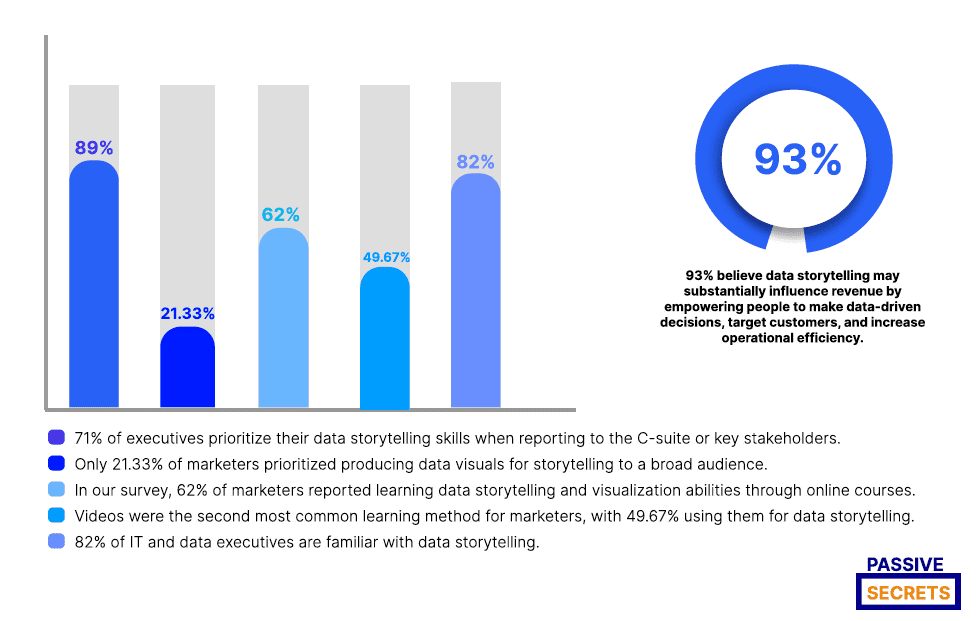
AI in Storytelling Statistics
49. AI can help with all aspects of video production, from scripting and storyboarding to automating the editing process and improving visual effects. (source)
50. AI-powered data stories are a game changer for Business Intelligence, influencing business decisions quickly and delivering business insights via more effective human interaction. (source)
51. Sunspring is a short film generated with an AI language model known as LSTM (Long Short-Term Memory). (source)
52. Researchers at the Massachusetts Institute of Technology (MIT) created Shelley, an AI program trained on horror stories and used to generate its own stories. (source)
53. Benoît Carré, a French composer and sound artist, released the first album created using AI software trained on a range of musical styles before composing the tunes. (source)
54. AI-generated resources can make stories more accessible to a larger audience. (source)
55. A survey revealed that 47% of book publishing houses incorporating AI employed it in their marketing departments. (source)
56. 47% of book authors in the US used AI as a grammar tool, and 29 % used it to brainstorm plot ideas and characters. (source)
57. Under 10% of authors in the US employed artificial intelligence to generate the text for their work. (source)
58. Using AI in storytelling can generate emotionally appealing narratives. (source)
59. AI helps develop characters and story arcs that deeply engage with more audiences by studying data on human emotions. (source)
60. AI-generated content plays a crucial role in data-driven storytelling, providing insights and narratives based on data. (source)
61. In a survey, 48% of respondents said they would interact with AI more than before if it could significantly impact customer experience with a brand. (source)
62. AI tools like ChatGPT are not 100% reliable enough to tell compelling stories. Instead, they are more suitable for doing the background work. (source)
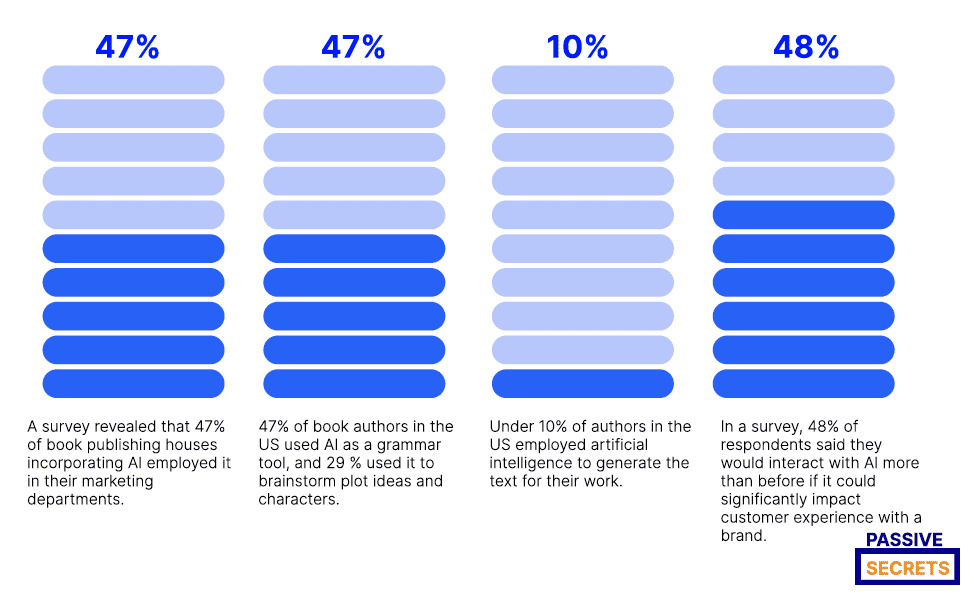
Latest Storytelling Trends to Look Out for in 2024
Here are some of the latest storytelling trends to look out for in 2024.
1. Interactive Storytelling
Interactive storytelling is a powerful new trend transforming how audiences engage with content.
It goes beyond traditional passive media consumption and allows audiences to participate in the narrative actively, shaping the outcome and exploring new possibilities.
Using interactive technologies like virtual reality and gamification, interactive storytelling creates immersive experiences that draw audiences in and keep them engaged.
This trend represents a significant shift in how brands and content creators approach storytelling.
Whether making choices that impact the storyline, exploring a virtual world, or playing a game, interactive storytelling creates a sense of personal investment that can lead to more meaningful and impactful experiences for audiences.
2. Personalization
This storytelling trend involves creating content that speaks directly to your specific audience rather than a broad, generic audience.
Using data-driven insights, brands, and content creators can tailor their messaging to specific demographics, interests, and behaviors. This creates a more personalized experience that resonates with each viewer or reader.
Hence, data storytelling is an essential marketing strategy for 2024 and beyond.
Personalization builds stronger connections with audiences, increases engagement, and ultimately drives better results for brands.
The trend is already popular in many industries, from retail to media to healthcare, and it’s expected to become more important in the future.
3. Short-form Video Storytelling
Thanks to TikTok, Instagram Reels, and YouTube Shorts, short-form video has become one of the most popular and engaging forms of content on the internet.
These videos are typically less than a minute long and designed to grab the viewer’s attention quickly and deliver a message or story concisely and impactfully.
Brands and content creators increasingly use short-form videos to connect with audiences, showcase their products or services, and create entertaining and shareable content.
Whether through dance challenges, comedy sketches, product demos, or educational content, short-form video storytelling is a versatile and effective way to engage with audiences and build a following.
4. Audio Storytelling
While visual content like video and images are still dominant in today’s digital landscape, audio storytelling is experiencing a resurgence in popularity.
Podcasts, in particular, have become a powerful medium for brands and content creators to connect with audiences on a deeper level.
It offers long-form, immersive storytelling experiences that can be consumed on the go.
Audio content can include audiobooks, voice-activated virtual assistants, and even voice-over work for videos and advertisements.
By leveraging the intimacy and convenience of audio storytelling, brands can create more engaging and memorable content that stands out in a crowded digital landscape.
5. User-generated Content (UGC)
UGC is a powerful way for brands to leverage their audience’s creativity and passion to create compelling and authentic storytelling.
User-generated content is any content created by users of a brand’s products or services rather than the brand itself. This can be social media posts, product reviews, customer photos, or even user-created videos or blog posts.
Brands can incorporate UGC in their storytelling to build trust and credibility with audiences.
People are more likely to trust content their peers created than a brand.
For more user-generated content, brands create hashtag challenges, run contests or giveaways, or simply engage with their audience on social media and encourage them to share their experiences.
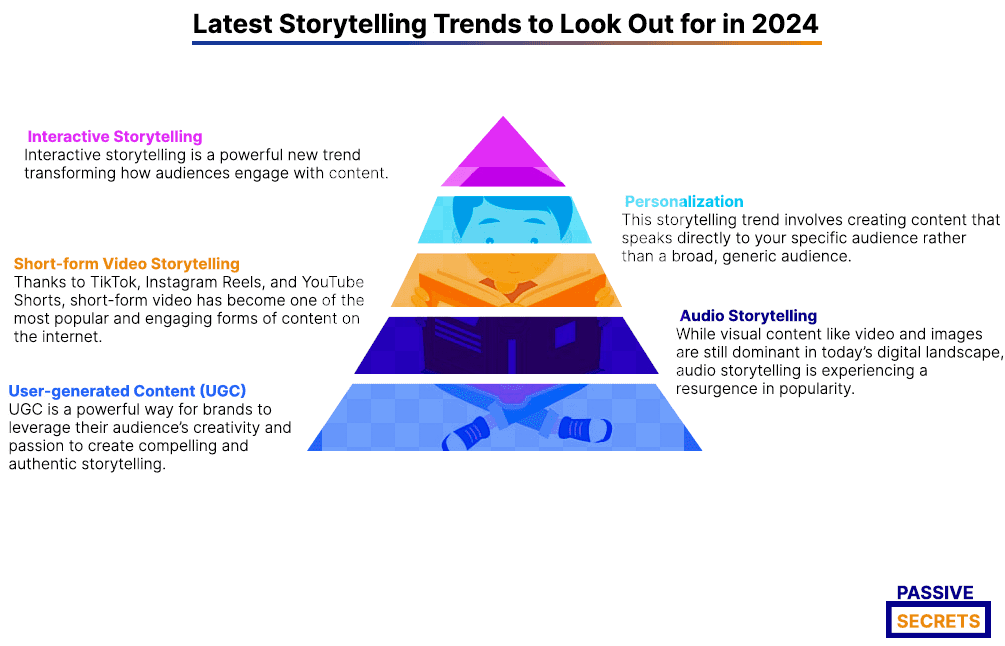
Conclusion
Storytelling is a powerful technique that can help businesses, organizations, and individuals communicate complex information in an informative and engaging way.
These storytelling statistics show that with the right approach, raw data can be turned into compelling stories that move audiences and drive results.
By leveraging data and storytelling, we can create compelling narratives that drive action, shape opinions, and inspire change.
Frequently Asked Questions
1. What are the Principles of Storytelling?
The principles of storytelling are character, structure, setting, plot, theme, style, and pacing.
2. What are the 6 Stages of Storytelling?
The stages in storytelling are exposition, rising action, climax, and resolution.
3. How is AI Used in Storytelling?
AI is being increasingly used in storytelling in various ways. For example, AI can generate story ideas, develop characters, craft dialogue, and structure plots. AI can also edit and proofread story scripts.
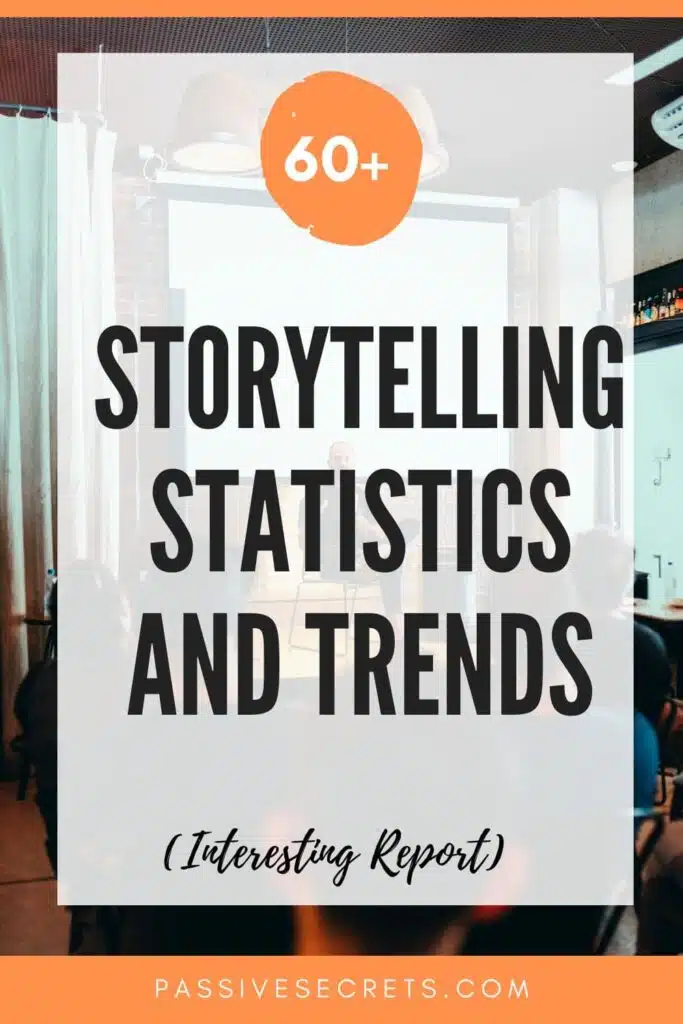
Other Related Statistics Posts:
- B2B Sales Statistics: Latest Insights and Trends
- 50+ Essential Traditional Marketing Statistics & Trends
- 60+ QR Code Statistics, Usage, Forecasts & Trends
- 90+ Useful Marketing Jobs Statistics & Facts (Latest Report)
- Sales Enablement Statistics: Data You Need to Drive Sales Growth
- In-store vs Online Shopping Statistics And Analysis
- Social Media Addiction Statistics
- Latest In-Game Advertising Statistics
- From Passion to Profit: 120+ Creator Economy Statistics
- 80+ Big Marketing Software Statistics
- 45 Interesting Healthcare Marketing Statistics & Trends
- Print Marketing Statistics: Ad Spending, Market Size, & More
- Key Short-Form Video Statistics and Trends You Should Know
- 49 Interesting Emotional Marketing Statistics
- 90 Amazing Millionaire Statistics
- 70+ Top Law Firm Marketing Statistics & NEW Trends
- Millennials on Social Media Statistics
- 23 Most Interesting First Impression Statistics To Know
- 60+ Interesting Storytelling Statistics, Facts & Huge Trends
- Amazon Book Sales Statistics: Intriguing Numbers and Facts
- 61+ Useful Podcast Advertising Statistics And Trends
- 50+ Useful Call Center Statistics And Trends
- 50 Crucial Amazon Advertising Statistics & Trends
- 65+ Must-Know Pay-Per-Click Statistics
- 40+ Interesting Omnichannel Marketing Statistics & Trends
- Multi-Level And Network Marketing Statistics, Facts & Trends
- Virtual Event Statistics & Benchmarks For Marketers & Organizers
- 55 Interesting Direct Mail Marketing Statistics and Trends
- B2B Lead Generation Statistics, Facts, Trends, Benchmarks, & Market Size
- 52 Valuable Trade Show Statistics and Trends
- 100+ Top Digital Marketing Vs. Traditional Marketing Stats
- 110+ Important Social Media Advertising Statistics & Trends
- 50 Interesting Organic Vs Paid Search Statistics To Know
- 41+ MOST Important Copywriting Statistics To Know
- 80+ Useful Sales Funnel Statistics & Conversion Rates
- 40+ Latest Multi-Channel Marketing Statistics & Huge Trends

